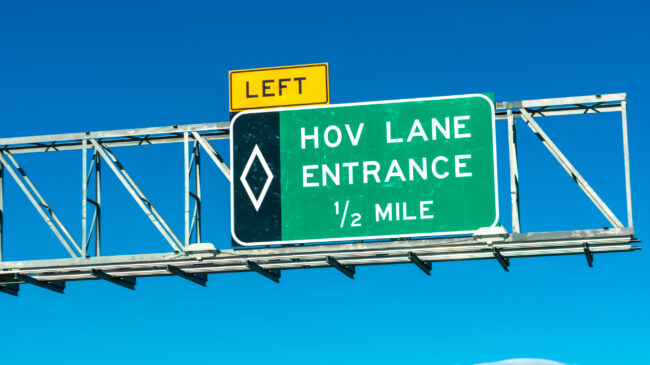In the 1970s, high-occupancy vehicle (HOV) lanes were implemented in an effort to reduce gasoline consumption. In the 1980s, HOV lanes, or carpool lanes, were justified as a way to try to reduce emissions by getting cars off the road during peak periods. By 2005, federal support for the lanes had led to 3,000 HOV lane miles. Yet, the concept of HOV lanes, even amongst past supporters, is now widely recognized as a failure. Why?
HOV Lanes Are Either Too Full or Too Empty
- Most HOV lanes suffer from “empty lane syndrome,” where the lane is underutilized.
- In other cases, HOV lanes are nearly as congested as regular freeway lanes during peak periods.
- This is the “Goldilocks problem”: HOV lanes are too crowded or too empty, but never just right.
Most People in HOV Lanes Are Not Carpooling
- As many as three-quarters of people using HOV lanes legally are either family members traveling together (fam-pools) or a parent driving kids to school (school pools) but neither situation removes vehicles from the roadways in the way that carpool lanes were intended to remove cars.
Large Fractions of HOV Lane Users Don’t Belong In the Lanes
- Enforcement of HOV lanes is difficult and costly.
- Solo drivers or cars with fewer than the required number of passengers add to traffic congestion in large urban-area HOV lanes.
- A 2018 study found 84% of the vehicles in Tennessee’s HOV lanes were violators.
As States Kept Adding HOV Lanes, Carpooling Declined
- Between 1995 and 2005, HOV lane miles doubled from 1,500 to 3,000 lane miles, but carpooling plummeted from 19.7% of commuters in 1980 to only 8.9% in 2019.
Changes in US Commuting Mode, 1980-2019 (percent of total)
| Mode | 1980 | 1990 | 2000 | 2010 | 2019 |
| Drive alone | 64.4 | 73.2 | 75.7 | 76.6 | 75.9 |
| Carpool | 19.7 | 13.4 | 12.2 | 9.7 | 8.9 |
| Transit | 6.4 | 5.3 | 4.6 | 4.9 | 5.0 |
| Work from home | 2.3 | 3.0 | 3.3 | 4.3 | 5.7 |
| Other | 7.2 | 5.1 | 4.2 | 4.5 | 4.5 |
HOV lanes have failed to stimulate carpooling or reduce congestion and emissions. States are increasingly converting the lanes to high-occupancy toll (HOT) lanes, where pricing keeps traffic flowing smoothly, reducing tailpipe emissions.


